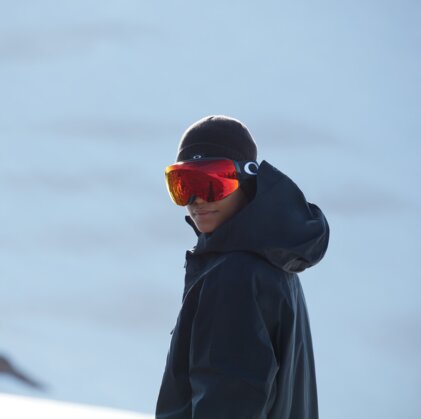
Who needs eye pain, a headache or blurred vision on a glorious day in the snow? Exactly: no one. That’s why it’s important to know about the condition that can cause all of the above (and worse): snow blindness.
Together with the eyewear experts of Oakley, we have compiled some useful information on how to prevent snow blindness and protect your eyes. Let’s go!
What is snow blindness and what causes it?
Essentially, snow blindness, or arc eye, is a sunburn on your eyes. Photokeratitis – that’s the medical term for snow blindness – is caused by too much exposure to ultraviolet (UV) light. Just like your skin, your eyes are sensitive to UV rays – that’s why we squint when the light gets too bright.
When too much UV light hits your cornea, it can get inflamed and irritated. Unfortunately, UV exposure can be a problem during some of the activities we love the most. As the sunlight reflects off the snow during skiing or snowboarding, it intensifies – causing damage to your eyes.
By the way: Snow blindness is more common in higher elevations, as cold temperatures can contribute to photokeratitis.
Is snow blindness only caused by snow?
No, snow blindness can occur in any environment with increased UV exposure. For instance, the sunlight intensifies when reflecting off snow, water or sand.
What’s more, light from blowtorches or tanning booths can also lead to photokeratitis. That’s why snow blindness is also sometimes referred to as “welder’s flash” – frequently affecting people who use welding equipment for a living.
What are the symptoms of snow blindness?
The tricky thing about snow blindness is that it can sneak up on you. Just like with sunburned skin, you often only notice the first symptoms when it’s too late.
Usually, the first symptoms of snow blindness occur several hours after UV exposure. They can include:
- eye pain
- watering eyes
- swollen, red eyelids
- eyelid twitching
- headaches
- blurred vision
- sensitivity to light
Keep in mind: Although snow blindness mostly causes minor vision problems like seeing halos around light sources, it can sometimes also cause temporary loss of vision.
How long does snow blindness usually last?
Fortunately, snow blindness is also similar to sunburned skin in that it will mostly heal on its own within one to two days.
However, while it’s usually not serious, it may be a good idea to see an ophthalmologist if symptoms are severe.
How can I treat snow blindness?
Although snow blindness will usually recede by itself, there are a couple of things you can do to alleviate the symptoms:
- Reduce sun exposure and give your eyes a rest.
- Stay indoors.
- Wear sunglasses to reduce light exposure.
- Remove your contact lenses.
- Use lubricating eyedrops.
- Use a cold compress.
Important: Try not to rub your eyes – this will only make things worse!
What can I do to prevent snow blindness?
There’s only one way to protect your eyes from too much UV exposure: good-quality ski goggles or sunglasses. Top-class ski goggle manufacturers such as Oakley offer full-coverage UV protection – and their products are worth the money!
After all, too much UV exposure can result in long-term damage to your eyes. For instance, resulting conditions include cataracts or eye cancer.
Did you know? Oakley’s Prizm lenses block 100 per cent of UVA and UVB rays and block UVC and harmful blue light up to 400 nanometers. They come in a multitude of tints and offer high contrast. Our top picks: Oakley’s Flight DeckTM L Snow Goggles and Line MinerTM L Snow Goggles.
Keep in mind: Also wear your goggles on overcast days, as UV rays can penetrate clouds!
INTERSPORT Rent tip
As we said before: The best way to prevent snow blindness is to protect your eyes with good-quality ski goggles. Where can you find those? At INTERSPORT Rent, of course!
At our more than 800 rental shops, we offer a great choice of ski goggles by leading manufacturers, all of them offering superb UV protection. Simply drop by, ask our RENTertainers on site for their recommendations and start your next mountain adventure with the perfect goggles!




